28 January 1778 Wednesday
Vases, Candelabra, Grave Stones, Sarcophagi. Tripods, Lamps and Ancient Ornaments volume I
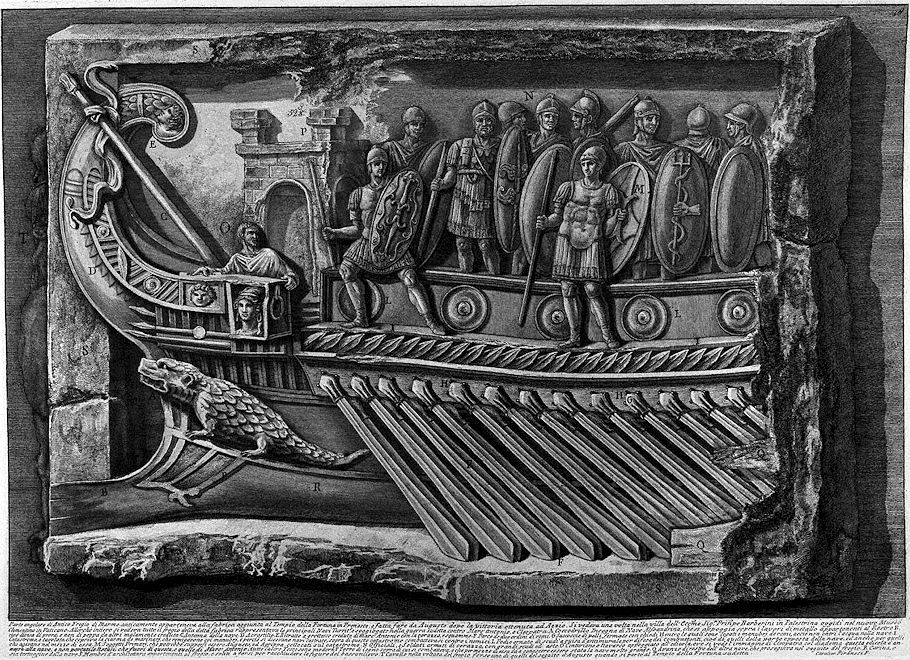
Corner part of an ancient marble frieze of the Temple of Fortuna in Preneste, representing a beaked ship.
Corner part of Ancient Marble Frieze formerly belonged to the building added to the Temple of Fortuna in Praeneste, and commissioned by Augustus after the victory obtained at Azzio. He was seen once in the villa of Ecc(ellentissimo)mo. Mr. Prin(ci)pe Barberini in Palestrina today in the new Clementine Museum in the Vatican. When the entire frieze of the said building was seen, it represented the main ships turreted and subjugated in the aforementioned war against Marc'Antonio and Cleopatra. A. Crocodile Insignia of Nave Alexandrina, which rests on the metal works belonging to the Rostrum B. i.e. divided at the prow, and not at the stern, badly believed by others. C. Ship antenna. D. Acrostyle. E. Grotesque portrait believed to be Marc'Antonio with cuirass and scales. F Part of two rows of oars. G Leather bags fastened with nails H inside which the handlebars of the oars are tied, so that water does not enter the ship. The Catastromo, or plank, which covered the crew of sailors, who rowed with the dumbbells, and therefore were called forced ships, fought against the enemies above this catastromo. The podium decorated with shields as an antimural for the defense of the Fighters, i.e. those on the opposite side of the ship, and also for those who acted in the middle of it. M Primary subjects, who could be supposed to be Augustus and Agrippa, placed on the catastrophe. N Officials, and Soldiers armed with cuirasses, with large shields and spears. O Centurion or Navarch leaning against the aedicule, where the image of Cleopatra with the diadem is seen, this aedicule is attached to the ship, and not portable Note, that apart from this one, and those of Marc'Antonio, all the other heads are modern .e P Wooden tower over which they fought, and which by means of it shows that the ship was very large. Q Remnant of rostrum of the other ship, which continued in the continuation of the frieze. R Carina, or ship's tortoise. S Members of architecture belonging to the frieze, and usually done to enclose the figures of the bas-relief. T Horse in the vault of the frieze perhaps one of those of Augustus' retinue when he was brought to the aforementioned Temple of Fortuna.
Cavalier Piranesi F.
28 January 1784
Gustavus III leaves Rome for Naples; on 10th March he returns to Rome.
28 January 1812 Tuesday
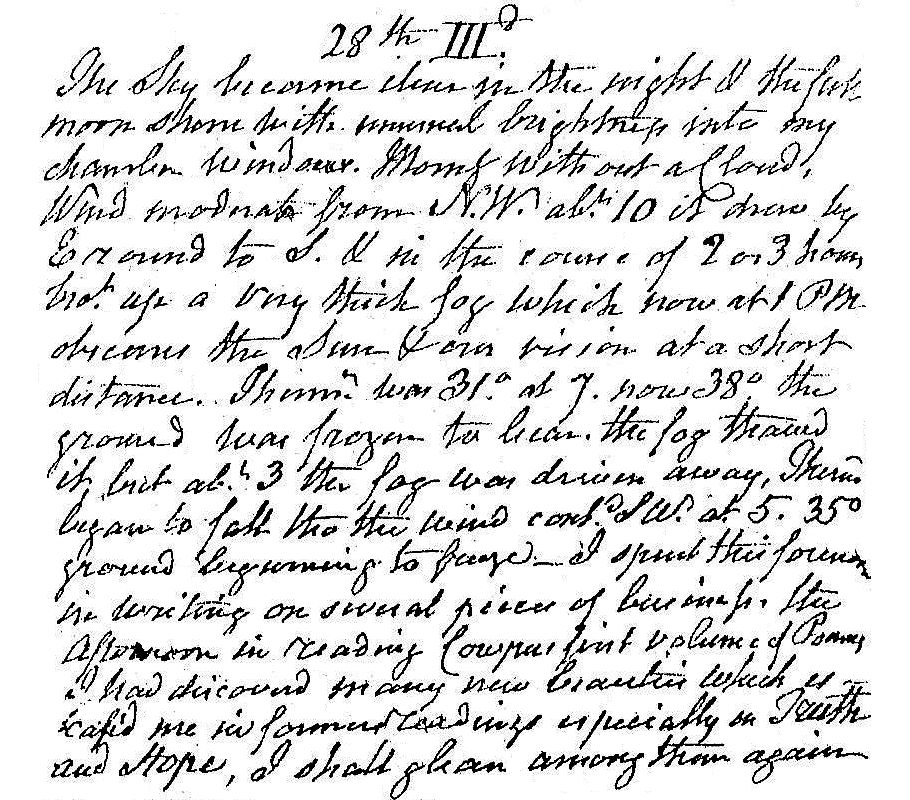
The sky became clear in the night and the full moon shone with unusual brightness into my chamber windows. Morning without a cloud, wind moderate from N.W., about 10 it drew E round to S and in the course of 2 or 3 hours brought up a very thick fog which now at 1 PM obscures the sun and our vision at a short distance. Therm. was 31° at 7, now 38. The ground was frozen to ..... The fog thawed it, but about 3 the fog was driven away. Therm. began to fall tho the wind continued SW at 5 35° ground beginning to freeze.
I spent the forenoon in writing on several pieces of business, the afternoon in reading Cowper's first volume of poems. I had discovered many new beauties which escaped me in former readings, especially on truth and hope. I shall glean among them again.
28 January 2007
maybe, maybe not
1945.10.04
The Evening Bulletin
ANCIENT URY HOUSE SOLD TO CATHOLICS
...Soon after William Penn's arrival the property was acquired by the Taylor family and later was visited by Penn's grandsons, who amused their hosts by their disregard for the sober and plain living of the Founder.
Jefferson's pecan tree, planted on the lawn, is still a family tradition. Edward VII, who always complained he could never distinguish between scrapple and biddle, visited [1860.10.9-11] the house when he was Prince of Wales.
[The first paragraph rings true, whereas the second paragraph leans heavily toward complete fabrication.]
28 January 2015
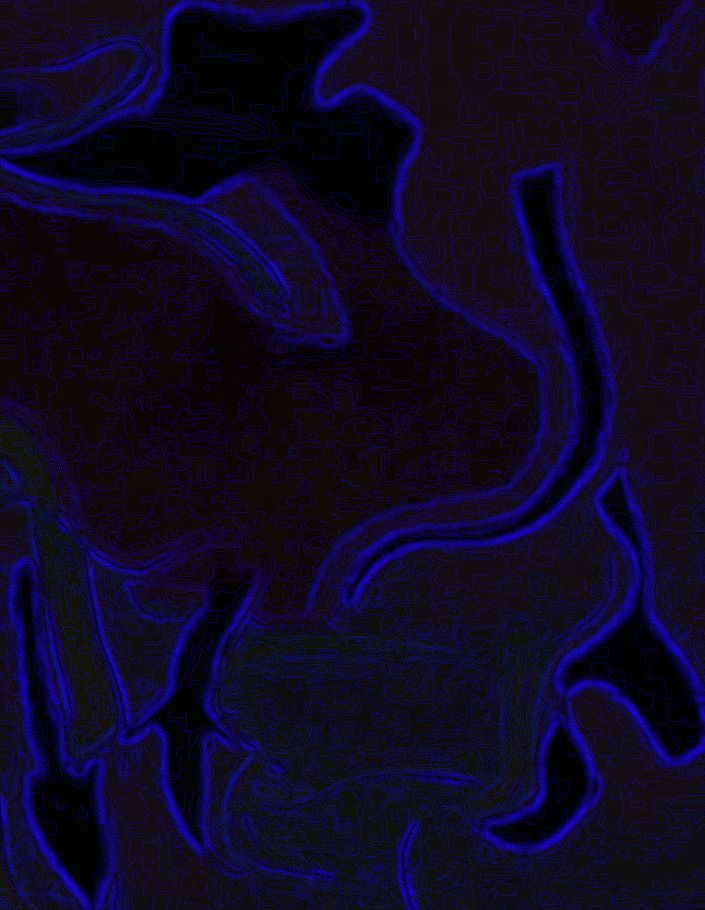
Virtual Painting 064
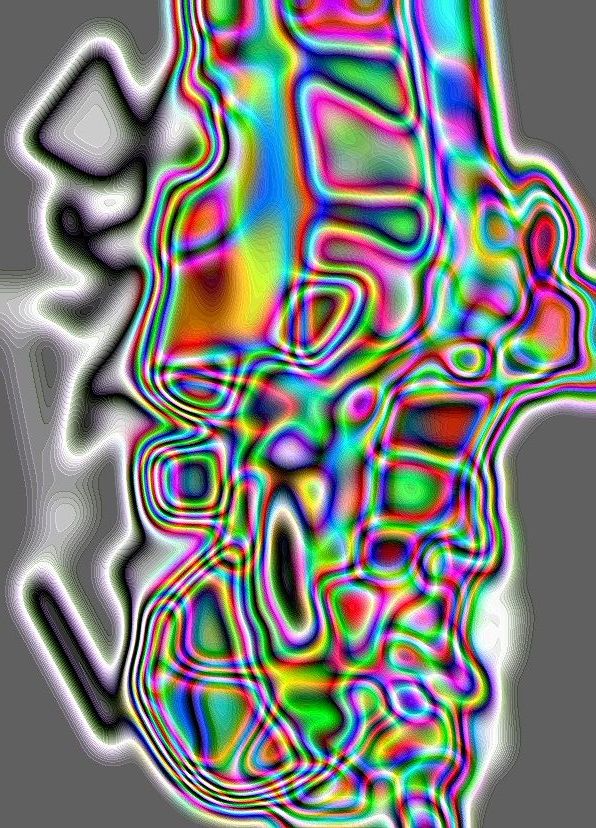
Virtual Painting 069
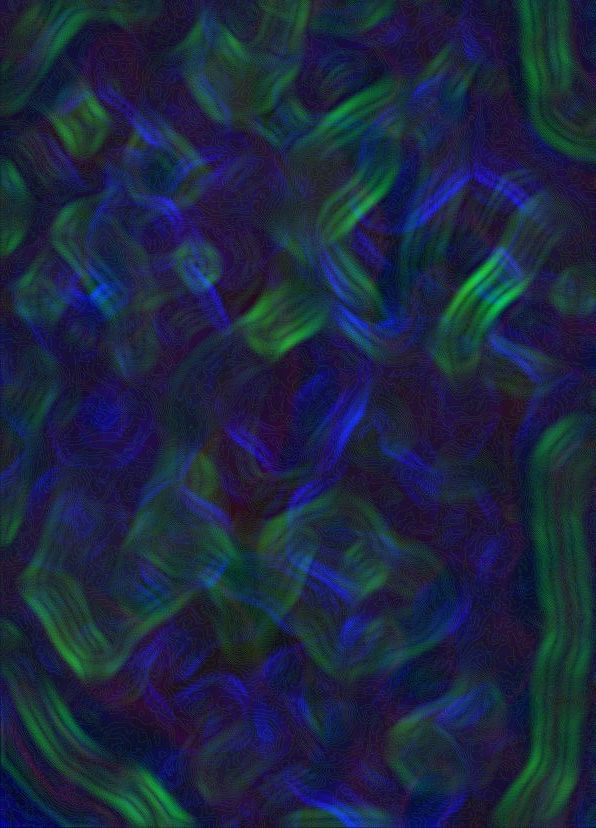
Virtual Painting 082
28 January 2023 Saturday
1790 Raccolta de'Tempj antichi vol. II
1792 Francesco publishes the general plan of Pompeii, dedicated to Gustav III. 29 March: assassination of Gustav III at the Royal Palace, Sweden. Francesco becomes political informant gathering news on the activities of Baron Armfelt. After Gustav III's death, Armfelt was a leader in the group of opposition Gustavians who were critical of Gustaf Adolf Reuterholm, the strong man in the regency of Gustav IV Adolf. Reuterholm appointed Armfelt minister of Naples, which was a way of relegating him far from the center of events.
1793 Ragguaglio ossia giornale della venuta e permanenza in Roma di S.A.R. Sofia Albertina Principessa di Svezia January Francesco commissioned to take care of the stay of Princess Sofia Albertina, sister of Gustav III who came to visit Rome. Francesco accompanied her on her visits to Rome and to Tivoli, Albano, Genzano and Castel Gandolfo. Of this stay he is in charge of writing a chronicle. 5 March: Princess Sofia Albertina visits Righetti’s studio in the strada della Purificazione, and in the same month she also visited Giovanni Volpato, Alessandro Cades, Giuseppe Valadier, Morelli, Bartolomeo Cavaceppi, Cristoph Unterperger, Gregorio Fidanza, Wenzel Peter, Giovan Battista Dell’Era, Carlo Albacini, Massimiliano Laboreur and once again Angelica Kauffmann.
1794 Benedetto Mori is threatened with arrest and, in turn, hidden by Francesco for 16 months. Lettera di Francesco Piranesi al Signor Generale D. Giovanni Acton May: Francesco appointed Swedish Minister in Rome, and holds the position till 12 January 1798 30 August: Francesco sent Reuterholm a list of the contents of the cases he had just dispatched to Stockholm.
1795 25 November: death of Jonas Åkerström; Francesco and Carlo Bassi are present at his deathbed. 26 November: funeral of Jonas Åkerström at the Protestant Cemetery in Rome, arranged by Francesco.
The Trophy or Magnificent Spiral Column of marble composed of large drums on which are carved the two Dacian Wars of Trajan, raised in the middle of the large Forum, erected in honor of the same Emperor on the order of the Senate and People of Rome after his Triumph; Columna Antonina
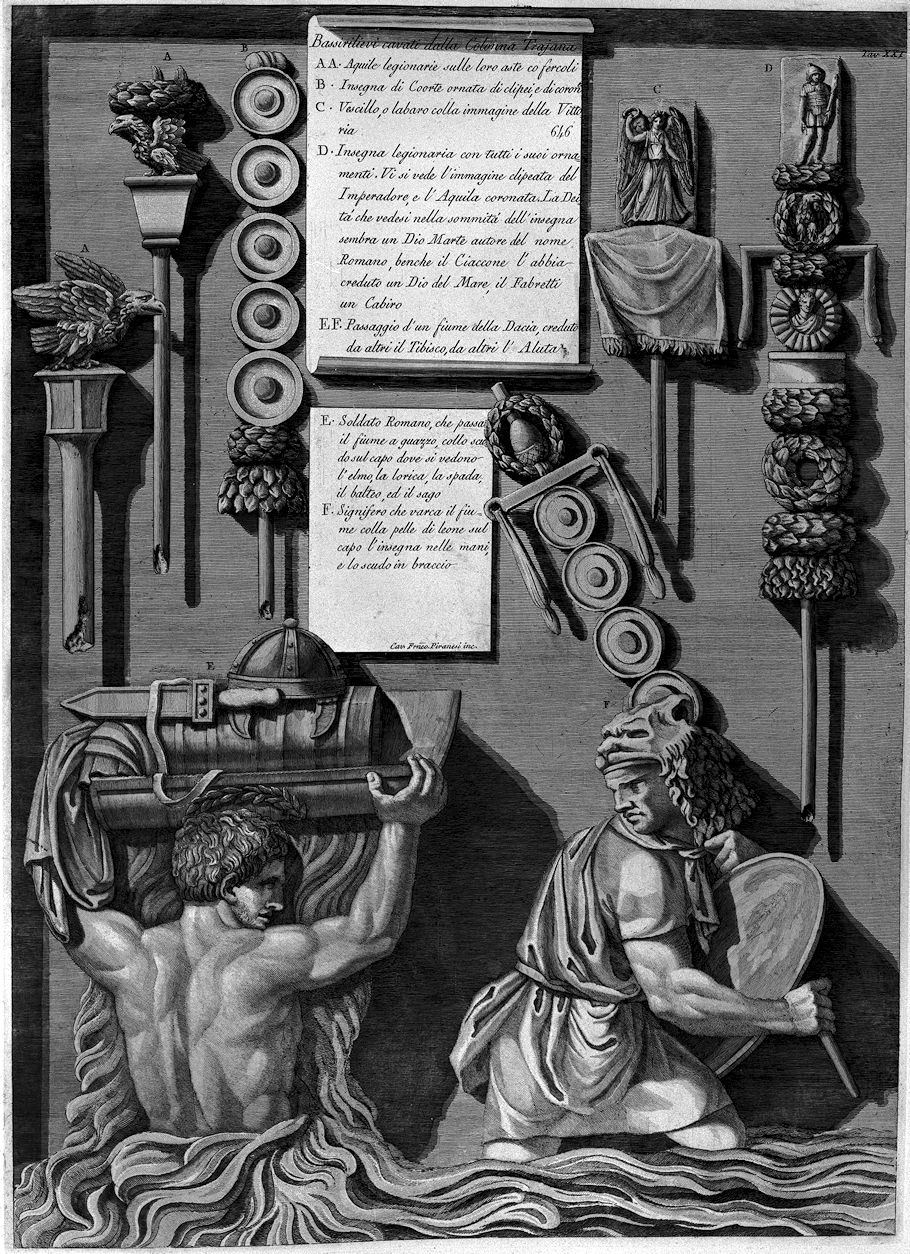
Eagles, insignia, banner; two legionaries at a river ford.
Bas-reliefs taken from Trajana's Column
A A. Legionary eagles on their spears co fercoli
B. Cohort insignia adorned with clypei and crowns
C. Vescillo, or labarum with the image of Victory
D. Legionnaire insignia with all its ornaments. There is seen the clipped image of the Emperor, and the crowned eagle. The Deity seen at the top of the sign seems to be a God Mars author of the Roman name, although Ciaccone believed him to be a God of the Sea, Fabretti a Cabiro
E F. Crossing of a river in Dacia, believed by others to be the Tisza, by others the Aluta
E. Roman soldier, crossing the river in gouache, with a shield on his head where the helmet, the lorica, the sword, the baldric, and the sago can be seen
F. Meaning that he crosses the river with a lion's skin on his head, the insignia in his hands, and the shield in his arms.
Cav. Fr[a]nc[esc]o. Piranesi inc. 1774-9
|